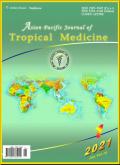用于检测钩端螺旋体DNA的锥形光纤DNA生物传感器
IF 1.6
4区 医学
Q3 PUBLIC, ENVIRONMENTAL & OCCUPATIONAL HEALTH
引用次数: 1
摘要
目的:建立基于锥形光纤的钩端螺旋体DNA检测平台,以钩端螺旋体secY基因为靶点检测钩端螺旋体DNA。方法:生物传感器的工作原理是光在特殊几何形状的光纤中传播,光纤从腰直径125到12µm逐渐变细。纤维表面通过一系列化学处理和固定靶向secY基因的DNA捕获探针实现功能化。目标DNA的存在是由光透射光谱中的波长位移确定的。结果:该传感器灵敏度高,检测浓度为0.001 ng/µL,对钩端螺旋体DNA具有选择性,与非钩端螺旋体微生物无交叉反应。该生物传感器通过环介导的等温扩增方法特异性检测DNA。结论:这些发现保证了该平台作为诊断钩端螺旋体病的一种新的替代方法的潜力。本文章由计算机程序翻译,如有差异,请以英文原文为准。
Tapered optical fiber DNA biosensor for detecting Leptospira DNA
Objective: To establish a DNA detection platform based on a tapered optical fiber to detect Leptospira DNA by targeting the leptospiral secY gene. Methods: The biosensor works on the principle of light propagating in the special geometry of the optical fiber tapered from a waist diameter of 125 to 12 µm. The fiber surface was functionalized through a cascade of chemical treatments and the immobilization of a DNA capture probe targeting the secY gene. The presence of the target DNA was determined from the wavelength shift in the optical transmission spectrum. Results: The biosensor demonstrated good sensitivity, detecting Leptospira DNA at 0.001 ng/µL, and was selective for Leptospira DNA without cross-reactivity with non-leptospiral microorganisms. The biosensor specifically detected DNA that was specifically amplified through the loop-mediated isothermal amplification approach. Conclusions: These findings warrant the potential of this platform to be developed as a novel alternative approach to diagnose leptospirosis.
求助全文
通过发布文献求助,成功后即可免费获取论文全文。
去求助
来源期刊

Asian Pacific journal of tropical medicine
PUBLIC, ENVIRONMENTAL & OCCUPATIONAL HEALTH-TROPICAL MEDICINE
CiteScore
4.00
自引率
9.70%
发文量
1936
审稿时长
3-8 weeks
期刊介绍:
Asian Pacific Journal of Tropical Medicine (ISSN 1995-7645 CODEN: APJTB6), a publication of Editorial office of Hainan Medical University,is a peer-reviewed print + online Monthly journal. The journal''s full text is available online at http://www.apjtm.org/. The journal allows free access (Open Access) to its contents and permits authors to self-archive final accepted version of the articles on any OAI-compliant institutional / subject-based repository.
APJTM aims to provide an academic communicating platform for international physicians, medical scientists, allied health scientists and public health workers, especially those of the Asia-Pacific region and worldwide on tropical medicine, infectious diseases and public health, and to meet the growing challenges of understanding, preventing and controlling the dramatic global emergence and re-emergence of infectious diseases in the Asia-Pacific.
The journal is proud to have an international and diverse editorial board that will assist and facilitate the publication of articles that reflect a global view on tropical medicine, infectious diseases and public health, as well as emphasizing our focus on supporting the needs of public health practitioners. The APJTM will allow us to seek opportunities to work with others who share our aim, and to enhance our work through partnership, and to uphold the standards of our profession and contribute to its advancement.
 求助内容:
求助内容: 应助结果提醒方式:
应助结果提醒方式:


